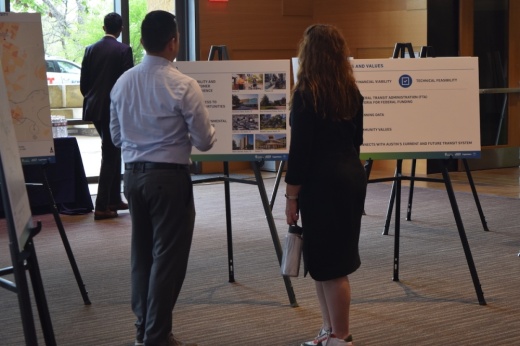The overview
Officials made the announcement via a news release May 17. According to the report, feedback suggested Austinites are interested in ensuring the light rail system:
- Provides good coverage
- Moves people more efficiently
- Attracts riders
- Allows for integration into current and future lines, CapMetro bus services, and bike and pedestrian network
- Manages traffic congestion
- Allows for reliable commutes
- Prioritizes transit where people live and work while reaching key destinations including schools, medical centers, job centers and areas around Austin including Austin-Bergstrom International Airport
Feedback from those who self-identified as Black, Indigenous or people of color, along with those who self-identified as low-income and current transit riders, all had one thing in common per the report: airport accessibility. However, only one iteration out of the five presented has a connection to the airport. According to the report, this option was the most frequently discussed and showed a strong preference for reaching the airport as a key destination.
Despite these findings, a memorandum issued May 11 to transit officials from Awais Azhar, chair of the Project Connect Community Advisory Committee, recommended two options that do not connect to the airport: On-Street 38th to Oltorf to Yellow Jacket, and On-Street North Lamar to Pleasant Valley.
"The CAC makes this recommendation based on community feedback, conversations with stakeholders and staff, data analysis, and alignment with systemwide design principles that CAC created in advance of the options being released," Azhar said in the memorandum.
Azhar said that either of the options recommended would expand transit services for the community and provide opportunities.
Officials from several organizations in the Austin area sent correspondence to ATP during the public engagement period, including Heidi Anderson, chief executive office for The Trail Conservancy—whose mission is to protect, enhance and connect the Ann and Roy Butler Hike-and-Bike Trail. In her letter to ATP on April 21, she said TTC supports the options with a Trinity Street crossing, wherein a rail line will cross Lady Bird Lake and, thus, the trail. Anderson said TTC officials landed on this conclusion because of the Trinity Street crossing's access to the trail, the minimal environmental consequences that could flow from a rail line crossing the trail, and the impact on trail users that the crossing will have. Three of the proposals from ATP feature a possible Trinity Street crossing including the On-Street 38th to Oltorf to Yellow Jacket, On-Street North Lamar to Pleasant Valley and On-Street 29th to the Airport.
Jeff Howard and Dewitt Peart, both members of the Downtown Austin Alliance—whose mission is to create, preserve and enhance the value and vitality of downtown Austin—also sent a letter to ATP. In the letter, dated May 10, DAA officials recommended the On-Street 38th to Oltorf to Yellow Jacket option with an extension to 45th Street, while continuing to identify ways to include an extension to the airport. They came to this conclusion based on this option minimizing traffic impacts, maintaining local access for existing and planned properties, and ensuring the transit system supports the large volume of existing and future development downtown, officials said in the letter.
What's next
ATP officials plan to unveil the final recommendation for the Austin Light Rail implementation plan the week of May 22. They will then present the recommendation to the ATP and Capital Metro boards, along with Austin City Council. After ATP officials present their recommendations to the boards and council, a decision on which phase to implement first will be made in early June.
Quote of note
“Austin Transit Partnership worked diligently to operate in full transparency as we sought community feedback during this vital process,” said Greg Canally, executive director of ATP, in the news release. “We know how crucial it is to have this feedback from people all over our city with different levels of current transportation access, and we believe we were able to reach those who need this system the most."
The backstory
Project Connect, originally estimated to cost $7.1 billion, was approved by voters in November 2020 with a property tax rate increase of $0.0875 to fund the project. ATP officials announced in spring 2022 that the light rail’s price tag almost doubled in cost due to inflation, rising labor and construction costs, and increased real estate values. As a result of the increased cost, officials had to make the decision to scale back the plans.





